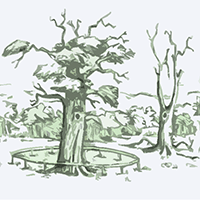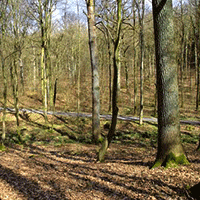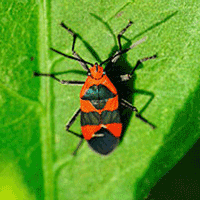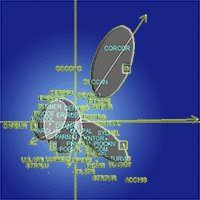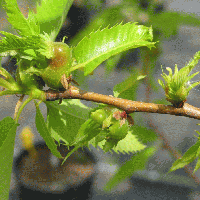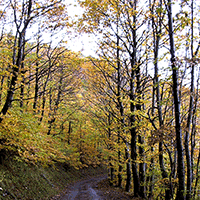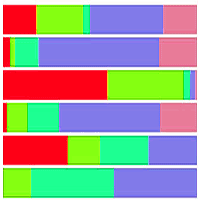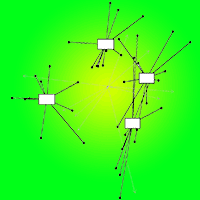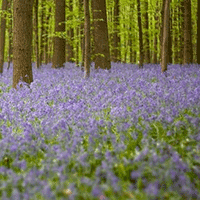Chestnut (Castanea sativa Mill.) has been exploited over the centuries for different uses. Nowadays, chestnut is mostly managed as coppice or orchard, creating a matrix of different forest structures. In particular, saproxylic species may provide information to correlate forest naturalness with stand structure. In this study, we evaluated how different management methods might influence the diversity of beetles hosted in chestnut agroforestry systems. Three management options were considered: young and mature coppice stands, and the traditional fruit orchard. Microhabitats occurring on veteran trees were also surveyed to investigate their effect on saproxylic communities, in the fruit orchard. The study area is located in Southern Italy, Aspromonte National Park, where Coleoptera were collected using window flight traps and the stand structural traits were also quantified. In the fruit orchard, a census of the occurring microhabitats was also realized. We used the following diversity indeces (α-diversity) to assess the state of conservation of the analysed forests: (i) Shannon Index; (ii) Margalef’s Richness index; (iii) Equitability index; (iv) Dominance index. Results revealed that forest management have a fundamental role in influencing the diversity of Coleoptera communities and saproxylic beetles. A lower species richness was observed in the mature coppice in comparison with the young coppice and fruit orchard. Nevertheless, these agroforestry systems, reflecting differentiated structural traits, allowed the development of highly specialized and threatened species (34.3% included in IUCN risk categories), with important contribution to conservation of biodiversity in the rural landscape. Finally, the abundance and diversity of microhabitats in the traditional fruit orchard had positive effects on many saproxylic beetle families. These beetle communities, particularly saproxylic species, can be used as excellent bioindicators in actively managed agroforestry systems, suggesting sustainable forest management options for chestnut, while the conservation of veteran trees rich in microhabitats can be considered fundamental for preserving many endangered insects.
Keywords
, , , , , ,
Citation
Parisi F, Lombardi F, Marziliano PA, Russo D, De Cristofaro A, Marchetti M, Tognetti R (2020). Diversity of saproxylic beetle communities in chestnut agroforestry systems. iForest 13: 456-465. - doi: 10.3832/ifor3478-013
Academic Editor
Mirko Di Febbraro
Paper history
Received: Apr 20, 2020
Accepted: Aug 04, 2020
First online: Oct 07, 2020
Publication Date: Oct 31, 2020
Publication Time: 2.13 months
© SISEF - The Italian Society of Silviculture and Forest Ecology 2020
Open Access
This article is distributed under the terms of the Creative Commons Attribution-Non Commercial 4.0 International (https://creativecommons.org/licenses/by-nc/4.0/), which permits unrestricted use, distribution, and reproduction in any medium, provided you give appropriate credit to the original author(s) and the source, provide a link to the Creative Commons license, and indicate if changes were made.

Breakdown by View Type
(Waiting for server response...)
Article Usage
Total Article Views: 39066
(from publication date up to now)
Breakdown by View Type
HTML Page Views: 32367
Abstract Page Views: 2760
PDF Downloads: 3249
Citation/Reference Downloads: 9
XML Downloads: 681
Web Metrics
Days since publication: 1894
Overall contacts: 39066
Avg. contacts per week: 144.38
Article Citations
Article citations are based on data periodically collected from the Clarivate Web of Science web site
(last update: Mar 2025)
Total number of cites (since 2020): 19
Average cites per year: 3.17
Publication Metrics
by Dimensions ©
Articles citing this article
List of the papers citing this article based on CrossRef Cited-by.
(1)
Angelini P, Casella L, Grignetti A, Genovesi P (2016)Manuali per il monitoraggio di specie e habitat di interesse comunitario (Direttiva 92/43/CEE) in Italia: habitat [Manuals for monitoring of species and habitat of community importance (Habitats Directive 92/43 /CEE) in Italy: habitat]. Serie Manuali e linee guida, ISPRA, Rome, Italy, pp. 142. [in Italian]
Gscholar
(2)
Audisio P, Alonso-Zarazaga M, Slipinski A, Nilsson A, Jelínek J, Vigna Taglianti A, Turco F, Otero C, Canepari C, Kral D, Liberti G, Sama G, Nardi G, Löbl I, Horak J, Kolibac J, Háva J, Sapiejewski M, Jäch M, Bologna M, Biondi M, Nikitsky N, Mazzoldi P, Zahradnik P, Wegrzynowicz P, Constantin R, Gerstmeier R, Zhantiev R, Fattorini S, Tomaszewska W, Rücker W, Vazquez-Albalate X, Cassola F, Angelini F, Johnson C, Schawaller W, Regalin R, Baviera C, Rocchi S, Cianferoni F, Beenen R, Schmitt M, Sassi D, Kippenberg H, Zampetti M, Trizzino M, Chiari S, Carpaneto GM, Sabatelli S, De Jong Y (2015)Fauna Europaea: coleoptera 2 (excl. series Elateriformia, Scarabaeiformia, Staphyliniformia and superfamily Curculionoidea). Biodiversity Data Journal (3): e4750.
CrossRef |
Gscholar
(3)
Bani A, Pioli S, Ventura M, Panzacchi P, Borruso L, Tognetti R, Tonon G, Brusetti L (2018)The role of microbial community in the decomposition of leaf litter and deadwood. Applied Soil Ecology 126: 75-84.
CrossRef |
Gscholar
(4)
Bouchard P, Bousquet Y, Davies AE, Alonso-Zarazaga MA, Lawrence JF, Lyal CHC, Newton AF, Reid CAM, Schmitt M, Slipinski SA, Smith ABT (2011)Family-group names in Coleoptera (Insecta). ZooKeys 88: 1-972.
CrossRef |
Gscholar
(5)
Bouget C, Brustel H, Brin A, Noblecourt T (2008)Sampling saproxylic beetles with window flight traps: methodological insights. Revue d’Écologie 10: 21-32.
Online |
Gscholar
(6)
Bouget C, Parmain G, Gilg O, Noblecourt T, Nusillard B, Paillet Y, Pernot C, Larrieu L, Gosselin F (2014)Does a set-aside conservation strategy help the restoration of old-growth forest attributes and recolonization by saproxylic beetles? Animal Conservation 17: 342-353.
CrossRef |
Gscholar
(7)
Carpaneto GM, Baviera C, Biscaccianti AB, Brandmayr P, Mazzei A, Mason F, Battistoni A, Teofili C, Rondinini C, Fattorini S, Audisio P (2015)A red list of italian saproxylic beetles: taxonomic overview, ecological features and conservation issues (Coleoptera). Fragmenta Entomologica 47: 53-126.
CrossRef |
Gscholar
(8)
Conedera M, Manetti MC, Giudici F, Amorini E (2004)Distribution and economic potential of the Sweet chestnut (
Castanea sativa Mill.) in Europe. Ecologia Mediterranea 30: 179-193.
CrossRef |
Gscholar
(9)
Dangles O, Jérôme C (2019)Ecosystem services provided by insects for achieving sustainable development goals. Ecosystem Services 35: 109-115.
CrossRef |
Gscholar
(10)
Dixon PM (1993)The bootstrap and the jackknife: describing the precision of ecological indices. In: “Design and analysis of ecological experiments” (Scheiner SM, Gurevitch J eds). Chapman and Hall, New York, USA, pp. 290-318.
Online |
Gscholar
(11)
EC (2007)Interpretation manual of European habitats - EUR27. European Commission, DG Environment, Brussels, Belgium, pp. 142.
Gscholar
(12)
Fahrig L, Merriam G (1994)Conservation of fragmented populations. Conservation Biology 8: 50-59.
CrossRef |
Gscholar
(13)
Giannini R, Maltoni A, Mariotti B, Paffetti D, Tani A, Travaglini D (2014)Valorizzazione della produzione legnosa dei boschi di Castagno [Enhancement of the wood production from chestnut forests]. L’Italia Forestale e Montana 69: 307-317. [in Italian]
CrossRef |
Gscholar
(14)
Greco S, Infusino M, Ienco A, Scalercio S (2018)How different management regimes of chestnut forests affect diversity and abundance of moth communities? Annals of Silvicultural Research 42: 59-67.
CrossRef |
Gscholar
(15)
Henneron L, Aubert M, Archaux F, Bureau F, Dumas Y, Ningre F, Richter C, Balandier P, Chauvat M (2017)Forest plant community as a driver of soil biodiversity: experimental evidence from collembolan assemblages through large-scale and long-term removal of oak canopy trees
Quercus petraea. Oikos 126: 420-434.
CrossRef |
Gscholar
(16)
Hjältén J, Hägglund R, Löfroth T, Roberge JM, Dynesius M, Olsson J (2017)Forest restoration by burning and gap cutting of voluntary set-asides yield distinct immediate effects on saproxylic beetles. Biodiversity and Conservation 26: 1623-1640.
CrossRef |
Gscholar
(17)
Horak J (2014)Fragmented habitats of traditional fruit orchards are important for dead wood-dependent beetles associated with open canopy deciduous woodlands. Naturwissenschaften 101: 499-504.
CrossRef |
Gscholar
(18)
Infusino M, Greco S, Turco R, Bernardini V, Scalercio S (2016)Managed mountain forests as diversity reservoirs in Mediterranean landscapes: new data on endemic species and faunistic novelties of moths. Bulletin of Insectology 69: 249-258.
Online |
Gscholar
(19)
Joys AC, Fuller RJ, Dolman PM (2004)Influences of deer browsing, coppice history, and standard trees on the growth and development of vegetation structure in coppiced woods in lowland England. Forest Ecology and Management 202: 23-37.
CrossRef |
Gscholar
(20)
Jönsson N, Méndez M, Ranius T (2004)Nutrient richness of wood mould in tree hollows with the scarabaeid beetle
Osmoderma eremita. Animal Biodiversity and Conservation 27: 79-82.
Online |
Gscholar
(21)
Larrieu L, Paillet Y, Winter S, Bütler R, Kraus D, Krumm F, Lachat T, Michel AK, Regnery B, Vandekerkhove K (2018)Tree related microhabitats in temperate and Mediterranean European forests: a hierarchical typology for inventory standardization. Ecological Indicators 84: 194-207.
CrossRef |
Gscholar
(22)
Lassauce A, Paillet Y, Jactel H, Bouget C (2011)Deadwood as a surrogate for forest biodiversity: meta-analysis of correlations between deadwood volume and species richness of saproxylic organisms. Ecological Indicators 11: 1027-1039.
CrossRef |
Gscholar
(23)
Lassauce A, Anselle P, Lieutier F, Bouget C (2012)Coppice-with-standards with an overmature coppice component enhance saproxylic beetle biodiversity: a case study in French deciduous forests. Forest Ecology and Management 266: 273-285.
CrossRef |
Gscholar
(24)
Lawrence JF, Newton AF, Pakaluk J, Slipinski SA (1995)Families and subfamilies of Coleoptera (with selected genera, notes, references and data on family-group named). Biology, Phylogeny, and Classification of Coleoptera 2: 779-1006.
Gscholar
(25)
Lindenmayer DB, Margules CR, Botkin DB (2000)Indicators of biodiversity for ecologically sustainable forest management. Conservation Biology 14: 941-950.
CrossRef |
Gscholar
(26)
Manning P, Slade EM, Beynon SA, Lewis OT (2016)Functionally rich dung beetle assemblages are required to provide multiple ecosystem services. Agriculture, Ecosystems and Environment 218: 87-94.
CrossRef |
Gscholar
(27)
Marti JA (2001)A new method for non-parametric multivariate analysis of variance. Austral Ecology 26: 32-46.
CrossRef |
Gscholar
(28)
Mattioli W, Mancini LD, Portoghesi L, Corona P (2016)Biodiversity conservation and forest management: the case of the sweet chestnut coppice stands in Central Italy. Plant Biosystems 150: 592-600.
CrossRef |
Gscholar
(29)
McArdle BH, Anderson MJ (2001)Fitting multivariate model to semi-metric distances: a comment on distance-based redundancy analysis. Ecology 82: 290-297.
CrossRef |
Gscholar
(30)
Micó E (2018)Saproxylic insects in tree hollows. In: “Saproxylic Insects: Diversity, Ecology and Conservation” (Ulyshen MD ed). Springer, Cham, Heidelberg, pp. 693-727.
CrossRef |
Gscholar
(31)
Moning C, Müller J (2009)Critical forest age thresholds for the diversity of lichens, mollusks and birds in beech (
Fagus sylvatica L.) dominated forests. Ecological Indicators 9: 922-932.
CrossRef |
Gscholar
(32)
Mosconi F, Campanaro A, Carpaneto GM, Chiari S, Hardersen S, Mancini E, Maurizi E, Sabatelli S, Zauli A, Mason F, Audisio P (2017)Guidelines for the monitoring of the saproxylic beetles protected in Europe. Nature Conservation 20: 23-264.
CrossRef |
Gscholar
(33)
Nadeau P, Thibault M, Horgan FG, Michaud JP, Gandiaga F, Comeau C, Moreau G (2015)Decaying matters: Coleoptera involved in heterotrophic systems. In: “Beetles: Biodiversity, Ecology and Role in the Environment” (Stack C ed). Nova Science Publishers Inc., Hauppauge, New York, USA, pp. 123-174.
Online |
Gscholar
(34)
Paillet Y, Archaux F, Boulanger V, Debaive N, Fuhr M, Gilg O, Grosselin F, Guilbert E (2017)Snags and large trees drive higher tree microhabitat densities in strict forest reserves. Forest Ecology and Management 389: 176-186.
CrossRef |
Gscholar
(35)
Paillet Y, Debaive N, Archaux F, Cateau E, Gilg O, Guilbert E (2019)Nothing else matters? Tree diameter and living status have more effects than biogeoclimatic context on microhabitat number and occurrence: an analysis in French forest reserves. PLoS One 14 (5): e0216500.
CrossRef |
Gscholar
(36)
Parisi F, Lombardi F, Sciarretta A, Tognetti R, Campanaro A, Marchetti M, Trematerra P (2016)Spatial patterns of saproxylic beetles in a relic silver fir forest (Central Italy), relationships with forest structure and biodiversity indicators. Forest Ecology and Management 381: 217-234.
CrossRef |
Gscholar
(37)
Parisi F, Pioli S, Lombardi F, Fravolini G, Marchetti M, Tognetti R (2018)Linking deadwood traits with saproxylic invertebrates and fungi in European forests - a review. iForest 11: 423-436.
CrossRef |
Gscholar
(38)
Parisi F, Di Febbraro M, Lombardi F, Biscaccianti AB, Campanaro A, Tognetti R, Marchetti M (2019)Relationships between stand structural attributes and saproxylic beetle abundance in a Mediterranean broadleaved mixed forest. Forest Ecology and Management 432: 957-966.
CrossRef |
Gscholar
(39)
Parisi F, Frate L, Lombardi F, Tognetti R, Campanaro A, Biscaccianti AB, Marchetti M (2020)Patterns of saproxylic species richness and diversity of Coleoptera communities in unmanaged forests of Mediterranean mountains. Ecological Indicators 110: 105873.
CrossRef |
Gscholar
(40)
Persiani AM, Lombardi F, Lunghini D, Granito VM, Tognetti R, Maggi O, Pioli S, Marchetti M (2015)Stand structure and deadwood amount influences saproxylic fungal biodiversity in Mediterranean mountain unmanaged forests. iForest 9: 115-124.
CrossRef |
Gscholar
(41)
Quinto J, Marcos-García MA, Díaz-Castelazo C, Rico-Gray V, Brustel H, Galante E, Micó E (2012)Breaking down complex saproxylic communities: understanding subnetworks structure and implications to network robustness. PLoS One 7 (9): e45062.
CrossRef |
Gscholar
(42)
Quinto J, De Los Angeles Marcos-García M, Díaz-Castelazo C, Rico-Gray V, Galante E, Micó E (2015)Association patterns in saproxylic insect networks in three Iberian Mediterranean woodlands and their resistance to microhabitat loss. PLoS One 10 (3): e0122141.
CrossRef |
Gscholar
(43)
Redolfi De Zan L, Bellotti F, D’Amato D, Carpaneto GM (2014)Saproxylic beetles in three relict beech forests of central Italy: analysis of environmental parameters and implications for forest management. Forest Ecology and Management 328: 229-244.
CrossRef |
Gscholar
(44)
Sabatini FM, Burrascano S, Azzella MM, Barbati A, De Paulis S, Di Santo D, Facioni L, Giuliarelli D, Lombardi F, Maggi O, Mattioli W, Parisi F, Persiani A, Ravera S, Blasi C (2016)One taxon does not fit all: herb-layer diversity and stand structural complexity are weak predictors of biodiversity in
Fagus sylvatica forests. Ecological Indicators 69: 126-137.
CrossRef |
Gscholar
(45)
Salmon S, Artuso N, Frizzera L, Zampedri R (2008)Relationships between soil fauna communities and humus forms: response to forest dynamics and solar radiation. Soil Biology and Biochemistry 40: 1707-1715.
CrossRef |
Gscholar
(46)
Santopuoli G, Di Cristofaro M, Kraus D, Schuck A, Lasserre B, Marchetti M (2019)Biodiversity conservation and wood production in a Natura 2000 Mediterranean forest. A trade-off evaluation focused on the occurrence of microhabitats. iForest 12: 76-84.
CrossRef |
Gscholar
(47)
Siitonen J (2012)Threatened saproxylic species. In: “Biodiversity in Dead Wood” (Stokland JN, Siitonen J, Jonsson BG eds). Cambridge University Press, New York, USA, pp. 356-379.
Gscholar
(48)
Siitonen J, Ranius T (2015)The importance of veteran trees for saproxylic insects. In: “Europe’s Changing Woods and Forests: From Wildwood to Managed Landscapes” (Kirby K, Watkins C eds). CABI, Wallingford, UK, pp. 140-153.
CrossRef |
Gscholar
(49)
Sivilov O, Atanassova J, Zlatkov B (2011)Food plant spectrum of Oedemeridae species (Insecta, Coleoptera) based on pollen analysis (a preliminary study). Comptes Rendus de l’Académie Bulgare des Sciences 64 (2): 225-230.
Gscholar
(50)
Stokland JN, Siitonen J, Jonsson BG (2012)Biodiversity in dead wood. Cambridge University Press, Cambridge, UK, pp. 524.
CrossRef |
Gscholar
(51)
Tabacchi G, Di Cosmo L, Gasparini P (2011)Aboveground tree volume and phytomass prediction equations for forest species in Italy. European Journal of Forest Research 130: 911-934.
CrossRef |
Gscholar
(52)
Vacik H, Zlatanov T, Trajkov P, Dekanic S, Lexer MJ (2009)Role of coppice forests in maintaining forest biodiversity. Silva Balcanica 10: 35-45.
Online |
Gscholar
(53)
Zlatanov T, Schleppi P, Velichkov I, Hinkov G, Georgieva M, Eggertsson O, Zlatanova M, Harald V (2013)Structural diversity of abandoned chestnut (
Castanea sativa Mill.) dominated forests: implications for forest management. Forest Ecology and Management 291: 326-335.
CrossRef |
Gscholar
